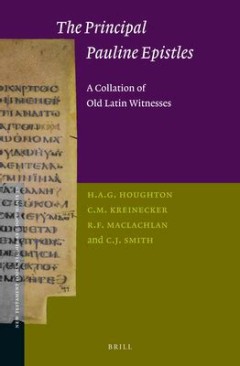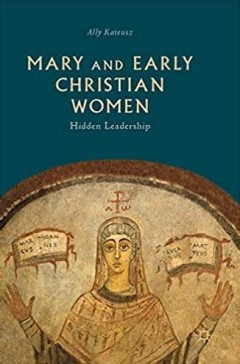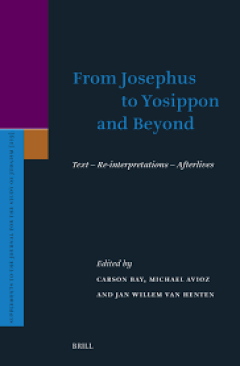Filter by

Les manuscrits arabes des lettres de Paul : État de la question et étude de…
Cet ouvrage ouvre une fenêtre sur la transmission des lettres de Paul en arabe. Il s’interroge sur le manque d’intérêt depuis le début du 20ème siècle pour les manuscrits arabes du Nouveau Testament et apporte une contribution à la récente reprise scientifique de ce champ, en étudiant le corpus largement inexploré des manuscrits arabes des lettres de Paul. Après un état des lieu…
- Edition
- -
- ISBN/ISSN
- 978-90-04-37816-2
- Collation
- xii, 550 pp.
- Series Title
- Biblia Arabica, Volume: 6
- Call Number
- -

Latin American Liberation Theology
David Tombs offers an accessible introduction to the theological challenges raised by Latin American Liberation and a new contribution to how these challenges might be understood as a chronological sequence. Liberation theology emerged in the 1960s in Latin America and thrived until it reached a crisis in the 1990s. This work traces the distinct developments in thought through the decades, thus…
- Edition
- -
- ISBN/ISSN
- 978-90-04-49646-0
- Collation
- xviii, 334 pp.
- Series Title
- Religion in the Americas, Volume: 1
- Call Number
- -

L’imaginaire du démoniaque dans la Septante : Une analyse comparée de la …
This book offers a thorough analysis of demons in the Hebrew Bible and Septuagint in the wider context of the ancient Near East and the Greek world. Taking a fresh and innovative angle of enquiry, Anna Angelini investigates continuities and changes in the representation of divine powers in Hellenistic Judaism, thereby revealing the role of the Greek translation of the Bible in shaping ancient d…
- Edition
- -
- ISBN/ISSN
- 978-90-04-46847-4
- Collation
- xiv, 392 pp.
- Series Title
- Supplements to the Journal for the Study of Judaism, Volume: 197
- Call Number
- -

Jesus and Other Men : Ideal Masculinities in the Synoptic Gospels
Now available in Open Access thanks to the support of the University of Helsinki. In Jesus and Other Men, Susanna Asikainen explores the masculinities of Jesus and other male characters as well as the ideal femininities in the Synoptic Gospels. She studies the masculinity of Jesus vis-à-vis his opponents, disciples, and women. She also considers the impact of Jesus’ emotions and suffering on…
- Edition
- -
- ISBN/ISSN
- 978-90-04-36109-6
- Collation
- x, 250 pp.
- Series Title
- Biblical Interpretation Series, Volume: 159
- Call Number
- -

Involving Readers : Practices of Reading, Use, and Interaction in Early Moder…
This volume explores how and by whom early modern Dutch Bibles were used. Through a detailed analysis of paratextual features and readers’ traces in over 180 surviving Bible copies, Renske Hoff shows how individuals manifested their faith in owning, reading, and personalising the Bible, in a period characterised by religious turmoil. From nuns and countesses to tailors and merchants: Bibles …
- Edition
- -
- ISBN/ISSN
- 978-90-04-69652-5
- Collation
- xviii, 332 pp.
- Series Title
- Library of the Written Word - The Handpress World, Volume: 129
- Call Number
- -

The Principal Pauline Epistles: A Collation of Old Latin Witnesses
The earliest Latin versions of the writings of the New Testament offer important insights into the oldest forms of the biblical text, the use of language in the ancient Church and the foundations from which Christian theology developed in the West. This volume presents a collation of Old Latin evidence for the four principal Pauline Epistles (Romans, 1 and 2 Corinthians and Galatians). The sou…
- Edition
- -
- ISBN/ISSN
- 9789004390492
- Collation
- 456 hlm; ill., lamp.,
- Series Title
- New Testament Tools, Studies and Documents, Volume: 59
- Call Number
- -

Human Nature in Gregory of Nyssa : Philosophical Background and Theological S…
This volume explores Gregory Of Nyssa's concept of human nature. It argues that the frequent use Gregory makes of phusis-terminology is not only a terminological predilection, but rather the key to the philosophical and theological foundations of his thought. Starting from an overview of the theological landscape in the early 360's the study first demonstrates the meaning and relevance of univ…
- Edition
- -
- ISBN/ISSN
- 978-90-04-27432-7
- Collation
- xii, 276 pp
- Series Title
- Vigiliae Christianae, Supplements, Volume: 46
- Call Number
- -

Mary and Early Christian Women = Hidden Leadership
This book is open access under a CC BY-NC-ND license. This book reveals exciting early Christian evidence that Mary was remembered as a powerful role model for women leaders—women apostles, baptizers, and presiders at the ritual meal. Early Christian art portrays Mary and other women clergy serving as deacon, presbyter/priest, and bishop. In addition, the two oldest surviving artifacts to d…
- Edition
- 1
- ISBN/ISSN
- 9783030111113
- Collation
- XVII, 295 hlm; ill., lamp.,
- Series Title
- -
- Call Number
- -

Hakol Kol Yaakov : The Joel Roth Jubilee Volume
Hakol Kol Yaakov: The Joel Roth Jubilee Volume contains twenty articles dedicated to Rabbi Joel Roth, written by colleagues and students. Some are academic articles in the general area of Talmud and Rabbinics, while others are rabbinic responsa that treat an issue of contemporary Jewish law. In his career, Joel Roth has been known as a scholar and teacher of Talmud par excellence, and, without …
- Edition
- -
- ISBN/ISSN
- 978-90-04-42046-5
- Collation
- xxxviii, 527 pp
- Series Title
- The Brill Reference Library of Judaism, Volume: 61
- Call Number
- -

From Josephus to Yosippon and Beyond : Text – Re-interpretations – Afterl…
Two millennia ago, the Jewish priest-turned-general Flavius Josephus, captured by the emperor Vespasian in the middle of the Roman-Jewish War (66–70 CE), spent the last decades of his life in Rome writing several historiographical works in Greek. Josephus was eagerly read and used by Christian thinkers, but eventually his writings became the basis for the early-10th century Hebrew text called…
- Edition
- -
- ISBN/ISSN
- 978-90-04-69329-6
- Collation
- xx, 662 pp.
- Series Title
- Supplements to the Journal for the Study of Judaism, Volume: 215
- Call Number
- 260 JOS
 Computer Science, Information & General Works
Computer Science, Information & General Works  Philosophy & Psychology
Philosophy & Psychology  Religion
Religion  Social Sciences
Social Sciences  Language
Language  Pure Science
Pure Science  Applied Sciences
Applied Sciences  Art & Recreation
Art & Recreation  Literature
Literature  History & Geography
History & Geography